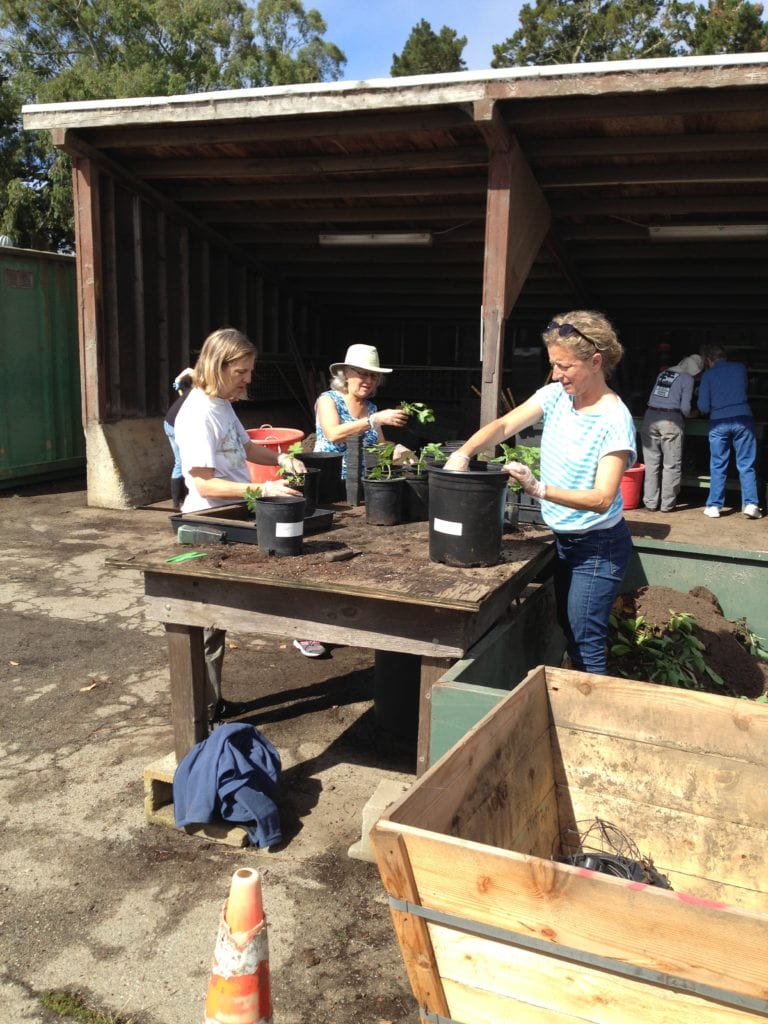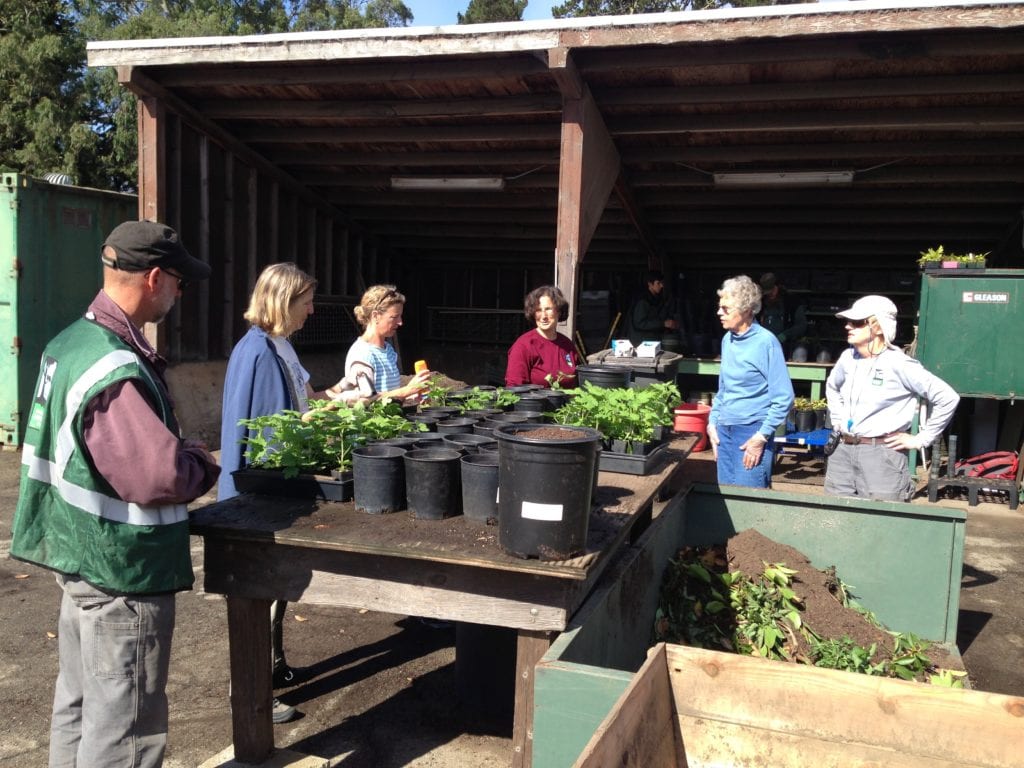Story and Photos by Murray Schneider

On June 26, five Friends of Glen Canyon Park volunteers played hooky and took a field trip. They put aside their familiar canyon tools and headed for Golden Gate Park.
Welcomed to the Recreation and Park’s nursery on Martin Luther King Drive by Licia De Meo, a Rec and Park gardener, they obtained a three-hour tutorial on how the Rec and Park’s Natural Areas Program propagates native plants. The plants, which had earlier been collected from Glen Canyon as seedlings, are scheduled for reintroduction to the neighborhood 70-acre Glen Park open space.
The five women, who are supervised by a NAP gardener each Wednesday, didn’t take along loose-leaf binders for a subsequent classroom “share-outs.” In fact, the only loose leaves they contended with dangled from plants, which awaited them in circular potting cones.
The women soon donned work gloves and began re-potting scores of California native plants deep within the nursery grounds and far removed from the public’s eyes.
“Not every volunteer group gets this experience,” said Gloria Koch, a recent initiate to the corps of women and very much aware of the privilege being afforded the Glen Park volunteers.
“This is the best kept secret,” said Koch, who worked 28 years as a Rec and Park gardener, manager, and supervisor and who retired one year ago.
The entrance to the nursery and maintenance facility is only a few feet from the park bowling lawns and more than a few yards from Kezar Stadium. Closer, children slid and climbed on the park’s state-of-the-art playground apparatus, where generations ago iconic Hippie Hill peaked adjacent to the Haight-Ashbury’s western frontier. Inside the nursery, Park and Rec trucks gassed up at a fuel pump and then exited, each vehicle rattling with loppers, handsaws and mattocks as it turned past where the ladies had parked their automobiles.
While the trucks fueled, Kay Westerberg and Alison Mitchell, who live on Chenery Street, Mary Huizinga, who lives on Laidley Street, Jean Conner, who lives on Sussex Street and Koch, who lives on Diamond Street tugged at their rubber gloves, then continued rubbing potting cones between their palms, in motions not unlike tectonic plates shifting.

Each plant slid to the wood tabletop amidst skirts of earth. Scooping at handfuls of back soil, the ladies repositioned each plant in a larger container, packing the midnight-hued dirt into place. Before long there were dozens of plants lined up in military tandem, awaiting the schooled eye of Park and Rec handlers.
Licia De Meo surveyed tray after tray of germinating native plants, some of which had been refrigerated at the Golden Gate Park nursery for up to five years.
The quintet of volunteers turned their green thumbs to additional pink flowering currant, sword fern and eventually sticky monkey flower, each familiar to them since over the years each had worked with the shrubs during weekly Wednesday work parties.

“The natives germinate well here,” said De Meo, glancing at several acres of grounds that house ornamental plants and California native plants. Both varieties will eventually make their way to trails in Golden Gate Park and to 32 Natural Areas overseen by the NAP.
The sun shone on the worktables and three volunteers took refuge in an adjacent potting shed where they could gain shade. Here they were assisted by two Rec and Park “Workreation” summer interns. Serena, who’d just graduated Terra Nova High School in Pacifica, and Brendon, who will graduate high school in 2014. Both were well-trained, knowledgeable and lent practiced hands to the project.
The real oversight, though, as the volunteers tamped down soil and pruned decomposing leaves from infant plants, belonged to De Meo and her NAP cohort, Randy Zebell.
“Randy looks at every tray,” said Gloria Koch, herself an experienced supervisor before she left the City’s employ. “It’s a skilled job, and he wants to get it correct because the roots are delicate and they can’t be too high or low.”

Zebell inspected each tray, putting it on a cart and then rolled it to a nearby area shaded by a khaki-colored porous tarp, which looked like what World War II infantryman used in the Solomon Islands to fend off mosquitoes. Beneath it the NAP stores hundreds of plants and shrubs, each awaiting reintroduction to such places as Glen Canyon, Bernal Hill, Corona Heights and Mount Davidson. Zebell retrieved a green garden hose from beneath a table and began showering the plants, which sat in parade ground rank formation.
“The City saves a tremendous amount of money by cultivating its own plants,” he said. “In this manner, too, we can oversee the genetics of the plants.”
He pointed to rows and rows of lupin, red elderberry, coffee berry, columbine, coyote brush, twinberry and grasses such as iris and purple needle grass.
 “All of these augment the biodiversity in natural areas such as Glen Canyon,” said Zebell, sounding every bit like one of the professors he took while earning a BA in biology and a MA in conservation biology at San Francisco State University.
“All of these augment the biodiversity in natural areas such as Glen Canyon,” said Zebell, sounding every bit like one of the professors he took while earning a BA in biology and a MA in conservation biology at San Francisco State University.
He pointed to dozens of canisters filled with soap plant, which the canyon volunteers only weeks before had weeded in its natural state, and which the Ohlone Indians once used to lather and clean their bodies.
“This plant is found in the Levi site,” he said about a protected canyon area near Islais Creek, which the NAP only last week surrounded with pristine green fencing just north of the Recreation Center and only feet from where a Great-Horned owl annually nests.
Sprinkling the plants, Zebell surveyed the rows.
“All of this,” he said, his arm sweeping the sheltered area, which acts as a temporary sanctuary for the plants, shrubs and grasses, “is really for several reasons: the greenery acts as habitat for bird, insects and animals, it prevents canyon soil erosion and it simply looks pretty.”
The group broke for snacks and water, resting at several shaded picnic tables. Instead of immediately resuming work, Gloria Koch led them on a nursery tour, taking in several of the spacious and airy green houses, again a courtesy the public would not necessarily ever be privy to.
The women returned to their worktables, redoubling their efforts but subsequently removed their gloves and headed for the gate.
Later, Licia De Meo summed up the morning experience, e-mailing one of the volunteers.
“Thanks for getting another generation of plants ready for planting in various projects, including Glen Canyon,” she wrote. “It helps us all to know them better as we observe their life cycle from small seedlings to mature, fruit bearing shrubs and trees.”
As for the ladies, well they enjoyed themselves so much they’re planning another excursion in two weeks for one more shot at the potting shed. Who knows? Their numbers may swell and they’ll require a school bus to transport them from their appointed Glen Canyon rounds and, best of all, no parent permission slips are required.
Licia De Meo made it clear they’ll be welcomed back.
“Hope to see you all again on July 24,” her e-mail read. “We’ll be sowing silver lupines for the Mission Blue butterfly habitat on Twin Peaks.”
Volunteers are welcome to work in Glen Canyon with the Recreation and Park’s Natural Areas Program staff. For more information, contact Joe Grey at 831-6328 or e-mail joe-grey@sfgov.org. Also, contact Jean Conner at 584-8576 for more information about Friends of Glen Canyon Park.